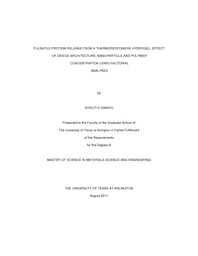
ATTENTION: The works hosted here are being migrated to a new repository that will consolidate resources, improve discoverability, and better show UTA's research impact on the global community. We will update authors as the migration progresses. Please see MavMatrix for more information.
Show simple item record
| dc.contributor.author | Gandhi, Shruti | en_US |
| dc.date.accessioned | 2012-04-11T20:56:02Z | |
| dc.date.available | 2012-04-11T20:56:02Z | |
| dc.date.issued | 2012-04-11 | |
| dc.date.submitted | January 2011 | en_US |
| dc.identifier.other | DISS-11243 | en_US |
| dc.identifier.uri | http://hdl.handle.net/10106/9569 | |
| dc.description.abstract | A pulsatile thermo-responsive drug delivery device for wound healing applications was developed in this study and its drug release during 24 hours of thermal cycling was characterized. The device consisted of a temperature sensitive hydrogel of poly (N-isopropyl acrylamide-co-acrylamide) (PNIPAM-AAm) nanoparticles (LCST: 39-40°C) embedded in a poly (ethylene glycol) diacrylate (PEGDA) matrix inside a device made of poly (methyl methacrylate). The device had four different orifice geometries all with the same surface area of opening (5 mm2): slit, cross, circle and four-circle. Bovine serum albumin (BSA) was loaded onto the hydrogel as the model protein. The effect of the orifice geometry on protein release was studied during temperature cycling alternating between 23.1 °C and 41°C. A factorial analysis was performed to study the effect of PNIPAM-AAm concentration (2% and 4% w/v), PEGDA concentration (10% and 15% w/v), and device geometry (slit and cross) on the BSA release rate during different cycles of the pulsatile release as well as the cumulative BSA released. Results indicate that device geometry plays a significant role in regulating protein release rates with cumulative release percentages varying from 46.98% (circle) to 84.34% (slit) over 24 hours of pulsatile release. Release profiles were observed to have an initial release phase with higher release followed by a steady state release period for which the release rates for each thermal cycle were similar. The PNIPAM-AAm enhanced the protein release whereas the PEGDA limited it. These results have given us insight on the effect of device geometry, nanoparticle as well as polymer concentration of a composite hydrogel, on drug release profile from a potential thermoresponsive wound healing dressing for controlled drug delivery. | en_US |
| dc.description.sponsorship | Aswath, Pranesh | en_US |
| dc.language.iso | en | en_US |
| dc.publisher | Materials Science & Engineering | en_US |
| dc.title | Pulsatile Protein Release From A Thermoresponsive Hydrogel: Effect Of Device Architecture, Nanoparticle And Polymer Concentration Using Factorial Analyses | en_US |
| dc.type | M.S. | en_US |
| dc.contributor.committeeChair | Aswath, Pranesh B. | en_US |
| dc.degree.department | Materials Science & Engineering | en_US |
| dc.degree.discipline | Materials Science & Engineering | en_US |
| dc.degree.grantor | University of Texas at Arlington | en_US |
| dc.degree.level | masters | en_US |
| dc.degree.name | M.S. | en_US |
Files in this item
- Name:
- Gandhi_uta_2502M_11243.pdf
- Size:
- 4.337Mb
- Format:
- PDF
This item appears in the following Collection(s)
Show simple item record


